Sobibor Escape – two films
One of the Third Reich’s most significant and darkest achievements was the efficient transport of “Untermenschen” to the gas chambers. Even with the tide turning in 1943 and the Russians pushing the Germans back to the Polish frontiers from where they started in June 1941, the gas chambers in Eastern Poland and Russia were busy. At that time, everyone really thought they were work camps. The universal despondency of the inmates meant that there were minimal or few escapes from these places. The reason was simple – where would the escapees go even if they escaped?
History was, however, made at the end of 1943 when two camps in Poland – Treblinka and Sobibor –filled with Jews and other “undesirables” suffered a revolt. In both cases, it was an armed uprising by the inmates. About 300 inmates escaped, and about 60 and 30 survived the war.
There is no film on the Treblinka escape (yet), while there are two films on Sobibor. Both differ in style and content though the end result in both films is the same – the mass armed breakout of Jewish prisoners.
Escape from Sobibor (1987) was a British TV film. One would think that a “TV film” would have budget constraints and a somewhat shoddy look. Escape from Sobibor is lavishly mounted with actual train stations, a set that looks like the real camp, and a sufficiently large crowd of extras and Hollywood Stars to anchor the story.
Leon (Alan Arkin) and others have been in the camp long enough to know how the system works. They whisper to new arrivals that they should say they have a trade or profession. Those who don’t, along with the young and the old, are immediately gassed.
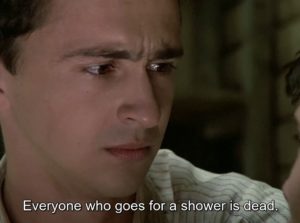
Soon everyone’s innocence is buried and it is now a game of survival. First against themselves, then against the KAPOs – trusted Jews who unleash mayhem on the Jewish prisoners in exchange for better food and living conditions. Finally, against the Germans.
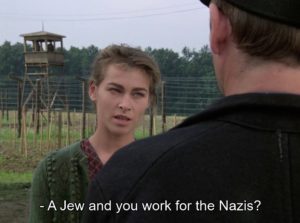
The Germans decided to shoot 10 prisoners for one who escaped. Their escapes suffer from the inevitable reprisals.
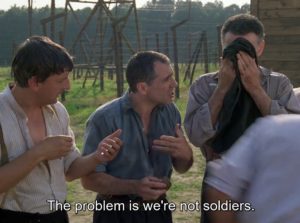
The situation changes when Alexander Sasha Pechersky (Rutger Hauer) and his team of Red Army soldiers are brought into the camp. Leon establishes contact with Sasha, and they decide that the best cover for their meetings would be a supposed romantic liaison between Sasha and seamstress Luka (Joanna Pacula).
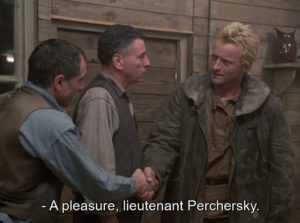
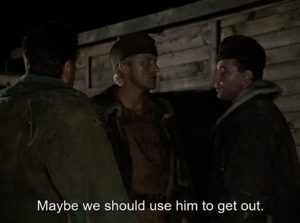
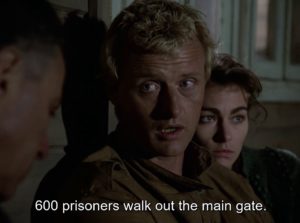
The plan is simple – the officers and guards will be lured into the sorting sheds with promises of new exotic material and killed silently. The plan proceeds, and soon the mass breakout follows.
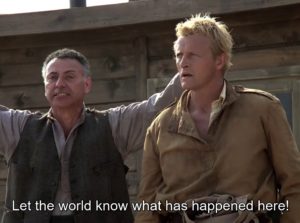
A voiceover at the end of the film narrates what happened to each character, after the escape.
Sobibor (2018) is entirely told from the perspective of Sasha, and all other characters are peripheral.
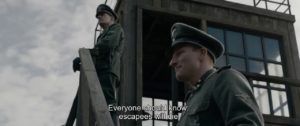
The Germans are super sadists and even have races with the inmates in place of horses. The tired “horses” are shot, and there is competition among the officers regarding whose “horse” is the strongest. Naturally, for a film sponsored by the Russian Ministry of Culture, there has to be a reference to Stalin. Sure enough, one of the characters says, “Sasha is able to do everything as he has Stalin in his heart . We all have Stalin in our hearts”. !
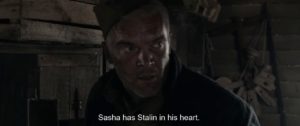
So with “Stalin in their hearts”, the inmates escape.
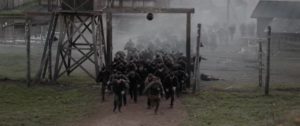
Now for the differences.
- Looks and appearance: The cast of the 1987 film looks very healthy and in the pink of health to the point of Hollywood glamorous. In the 2018 film, everyone has a tired grimy filthy look.
- Time of day – the 1987 version alternates between day and night, while the 2018 version looks like it has been filmed entirely at night.
- In the 2018 version, the gassing of women is shown, while in the 1987 version, we hear only talk and sometimes screams.
- The Germans were sadists in 1987, while they are super sadists in the 2018 version. No doubt some message was being sent to the Europeans. Perhaps in anticipation of all the later imbroglios between Russia and the West?
- The most significant difference is that the camp commandant was absent (as it really happened) in the 1987 version. In contrast, he is the first victim in the 2018 version.
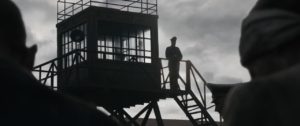
There are many more differences between the two versions, but it suffices to say that the former looks like a very polished well, crafted Hollywood-style product while the latter, due to its grimy look, has a more realistic appearance. However, the latter entirely focuses on Sasha, and it loses perspective completely, while the former has a wholistic well-rounded look to it.
In my view, the 1987 version is far superior and was filmed in the former Yugoslavia.
Real History – 5 out of 5
Equipment and Kit – 4 out of 5
Locations or substitutes – 4 out of 5
Script – 4 out of 5
Overall Rating – 4.3 out of 5
A slight diversion here: The Yugoslavian Government rented its Army and equipment for many Hollywood films in the 1960s, 1970s and 1980s to earn foreign exchange. It was also one of the few Armies with original WW2 vintage equipment. So this was a mutually assured profitable venture. Some movies that benefited from this generosity are Kelly’s Heroes, Force 10 from Navarone, Cross of Iron, The Winds of War (TV Series), its follow-up (War and Remembrance), and many more. More on that in some future posts.
Sobibor 2018 is available on Amazon Prime in Russian with English subtitles. Fair warning: The initial gassing of women is extremely disturbing.
Real History – 3 out of 5
Equipment and Kit – 4 out of 5
Locations or substitutes – 4 out of 5
Script – 3 out of 5
Overall Rating – 3.5 out of 5